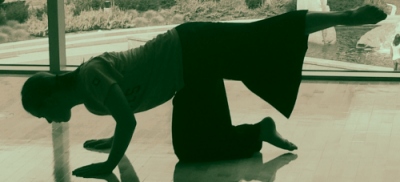No one likes to be told their posture is bad. Being told your posture is bad feels like judgment is being cast on your entire self. Bad posture makes you think of laziness, sloppiness or clumsiness none of these are positive qualities and few people like to use these words in describing themselves. The big question is why do we have bad posture? If you look a baby you will recognize that they sit with perfect posture, balancing their unstable torso upon their cushioned sitz bones. Good posture or alignment is really the most natural and efficient posture. If good posture is natural and we had it as babies what happened? The culprit is our environment. Office jobs, unsupportive chairs ad coaches, commuting for hours in cars, carrying a laptop everywhere, constantly holding and nursing a baby, over tasking by being on the phone, cooking dinner and tending to a child. There is not much you can do to alter your environment so we must turn to the mind and embrace a new perspective of posture.
It is a misconception that bad posture is a sign of aging and will happen to everyone. Yes, bad posture does occur in all types of people and especially in the elderly but we have a choice to submit our bodies to the pressure of our environment and to embrace natural alignment. The catch is in order to improve posture one must be willing, for a time to constantly retrain their muscles to allow them to support the skeleton achieving wonderful free posture.
When you think of good posture the phrase "stand up straight" jumps to mind but the ironic thing is your spine is not naturally straight. To improve posture one should not just straighten their spine because in reality they are just activating opposing muscles. For example hunched shoulders could be a result of contracted pectoral muscles amongst other things so by "straightening up" one activates certain back muscle to pull the shoulders back, attempting to lengthen the pectoral muscles, after doing this for a minute or so the opposing muscles are too weak and give into bad posture. An option to this monotonous routine of "straitening up" and "slumping forward" is the use of imagery. Imagery can teach the body to return to the basic patterns of efficient posture.
Why imagery? The great aspect of imagery is one image can encapsulate many variables. So, instead of having a list of To Do's: hold head up, shoulders back, feet beneath knees and knee's beneath pelvis, yield into the ground etc... An image can provide a way to accomplish the To Do list in one continual thought. Imagery also helps you claim your body and movement while connecting to your environment..
Imagery Examples
- Laying on the ground breathing deeply think of two streams side by side, coming into your body through your pubic bone filling the pelvis girdle, envision the steams rushing towards your lowest ribs and merging into one vigorous river propelling through each vertebrae of the spine flowing into the head and exploding beyond the hair into a glorious water fountain. This image is great to activate muscles to work efficiently and to develop a sense of true alignment or posture. One tried several time laying down attempt to feel the feeling of a flowing river as you stand. Once good alignment has been achieved while standing use this image when walking. This is a great way to offer recuperation to your body after a long day at the office; it kindly reminds the body of where it should be.
- Imagine you head is a balloon. Allow your head to take on the qualities of a balloon: flexible, filled with air, has the ability to expand and float. Think of a sting attached to the bottom of the balloon being rapped around you spine and tied at the tail bone. Imagine air in your head expanding reaching upwards and lengthening your spine. This is a great image to use if you are suffering with a headache; it realigns the head and opens space where nerves might have been pinched.
- Imaging that your ears are rotating forward and then outward. This is a great image if you feel your head is locked or you are experiencing jaw discomfort.
- As you are standing imaging that your feet are yielding into the floor and you spine is reaching upwards. Allow each breath to offer support and expand within you. This opens up space which removes pressure on joints and prevents certain muscles to over work.
- Imagine that butter is dripping off your scapula and running down to your tail bone. This is a great image to help release the upper trapezius muscles that have a tendency to hold the shoulders up especially when anxious, causing tightness and discomfort.
When using imagery it is essential to recognize that your body will not immediately change. Bad posture is a result of habits and it takes time to re-pattern muscle patterns within the body. By continually reminding the body to embrace an image will result in new habits that can afford good posture.
By Worldwidehealth Editor
All rights reserved. Any reproducing of this article must have the author name and all the links intact.






